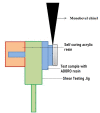Evaluation of Bond Strength of Resin and Non-resin Cements to Different Alloys
- PMID: 37128524
- PMCID: PMC10148197
- DOI: 10.7759/cureus.36894
Evaluation of Bond Strength of Resin and Non-resin Cements to Different Alloys
Abstract
Background: A strong metal-cement bond is one of the many factors that contribute to the clinical success of a fixed prosthesis. Even though it is crucial to create ideal resistance and retention forms during tooth preparation, dental cement must be strong enough to hold the restoration in place in the mouth. The present study set out to evaluate and compare the binding strength of resin modified glass ionomer cement, resin cement, and glass ionomer cement to four different metal alloys: titanium alloy, cobalt-chromium (Co-Cr) alloy, nickel-chromium (Ni-Cr) alloy, and noble metal alloys (silver palladium based).
Methods: Two hundred and forty metal alloy specimens were created; these were fashioned from (i) a noble metal alloy (silver-palladium based), (ii) a titanium alloy, (iii) a cobalt-chromium alloy, and (iv) a nickel-chromium alloy. A universal testing machine was used to perform the shear test, and statistical analysis of the result was done using a two-way analysis of variance (ANOVA) test and Bonferroni test. Results: The Co-Cr alloy among the cement under investigation had the highest mean value of shear bond strength of 8.06 MPa, whereas a noble metal alloy had the lowest shear strength with a mean value of 5.36 MPa. The resin cement demonstrated the highest shear strength with a mean value that was higher than the other two types of cement. The shear bond strength of the examined samples was significantly affected by the interaction of the alloy and cement, according to the two-way ANOVA test (p=0.001).
Conclusion: The results demonstrate that resin cement offers a stronger bond, followed by resin-modified GIC and GIC. The Co-Cr alloy had the highest shear bond strength, followed by Ni-Cr, titanium, and noble metal alloy which showed significantly lower shear strength than the other three alloys.
Keywords: alloy; bond strength; fixed prosthesis; metal-cement bond; resin.
Copyright © 2023, Mann et al.
Conflict of interest statement
The authors have declared that no competing interests exist.
Figures
References
-
- A survey of crown and fixed partial denture failures: length of service and reasons for replacement. Walton JN, Gardner FM, Agar JR. J Prosth Dent. 1986;56:416–421. - PubMed
-
- Adhesive bonding of composite material to cast titanium with varying surface preparations. Yanagida H, Matsumura H, Taira Y, Atsuta M, Shimoe S. J Oral Rehabil. 2002;29:121–126. - PubMed
-
- Effect of three adhesive primers for a noble metal on the shear bond strengths of three resin cements. Yoshida K, Kamada K, Sawase T, Atsuta M. J Oral Rehabil. 2001;28:14–19. - PubMed
-
- In vitro shear bond strength of cementing agents to fixed prosthodontic restorative materials. Piwowarczyk A, Lauer HC, Sorensen JA. J Prosthet Dent. 2004;92:265–273. - PubMed
LinkOut - more resources
Full Text Sources




